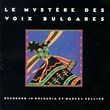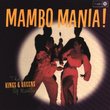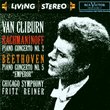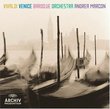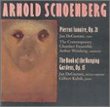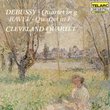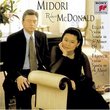Beautifully performed and superbly recorded late chamber wor
Christopher Culver | 07/23/2006
(5 out of 5 stars)
"This Naxos disc contains several chamber works by Toru Takemitsu, the self-taught Japanese composer who was one of the most singular composers of the 20th century. They are performed by flautist Robert Aiken and several other Toronto-based musicians with whom Takemitsu formed a close relationship. With the exception of a single piece, all are from the last two decades of his life, after his modernist apogee and when he had entered a "sea of tonality".
"Voice" for solo flute (1971) is the only piece here from Takemitsu's modernist middle-period. Its writing is rougher than other pieces, sometimes a lot and at other times not much so, and it makes use of quarter-tones. But what really sets it apart is Takemitsu's having the performer shout, sing, and hum into the instrument, amplifying and treating his voice. The opening, with some bold words by Japanese poet Shuzo Takiguchi, will snap you out of any trance entered from the other works. At times it sounds like flute-meets-Ligeti's "Aventures", and so comes across as rather dated, but still it comes across as a nice change of pace on a disc having otherwise only late works. This performance stands in interesting contrast with that of Aurele Nicolet on the DG "Echo 20/21" disc; Aiken's is polished and prim, while Nicolet, the work's dedicatee, gives a rougher and more primal go at it. By the time "Bryce" for flute, two harps, marimba, and percussion (1976) was written, Takemitsu had already left modernism behind and one immediately notices a consistent meditative feel, though it retains the usual touches of quarter-notes and improvisation. I find little that grabs me in this work, and think it the only ho-hum piece on the disc. Takemitsu was clearly still perfecting a new idiom.
"And then I knew 'twas wind" for flute, viola, and harp (1992) bears more than a passing resemblance with Debussy's "Sonata" for the same three instruments, and shares with the French composer's work the interest in timbre for its own sake that marked all of Takemitsu's late works. Takemitsu has been criticized, even by supporters such as Oliver Knussen, of cutting all his final works from the same general carpet, with all being quite mellow and some overly so. This piece, however, really stands out for its dynamic interactions of the three instruments, with the flute often leaping above the encumberance of the other two. This recording is dazzling, much brighter and crystal-clear than the recording in Deutsche Grammophon's "20/21" series.
"Rain Tree" for three percussion players (1981) is glorious. It is related to the later "Rain Tree Sketch" and "Rain Tree Sketch II" for piano, but the expanded timbres and greater use of hall space in this original version make it transcendently beautiful. Two of the percussionists here, Russell Hartenberger and Bob Becker, are members of the Nexus percussion ensemble for whom Takemitsu wrote his "From me flows what you call Time" piece, which is on a worthy Sony disc.
The theme of water is continued in two other works on this CD. "Toward the Sea" for alto flute and guitar (1981) was written for Greenpeace's "Save the Whales" campaign, and is in three movements titled "The Night", "Moby Dick" and "Cape Cod". The flute's melodic line often exhibits a raising three-note phrase S-E-A (German notation having "Es" for "E flat"), while arpeggios on the guitar give a gently undulating touch like the surface of the ocean. This performance is equal to that on DG, but preferable to the Sony recording with John Williams, the London Sinfonietta, and Salonen which lacks confidence. "Rain Spell" for flute, clarinet, harp, piano, and vibraphone (1983) has with arpeggios on the strings evoking the flow or currents. The clarinet, however, performed her by Joaquin Valdepenas, gives a very odd timbre compared by some to insects. The general form of the work is that the melodies get progressively longer.
"Itinerant" for solo flute (1989) was written in memory of the sculptor Isamu Noguchi. It is notable for its slow pace and extremely conservative nature. Silence is an important factor here, and much of the work purposefully consists of what the performer does *not* play. Takemitsu's final work, "Air" for solo flute (1995), continues in this style, but eschews unusual techniques, giving it an even greater simplicity. It was taken from material developed for a work for flute, harp, and orchestra that was not to be, for Takemitsu's untimely death came the next year. The piece is a set of variations in rondo form on a four-note motif, with an interest in ascending and descending scales.
This might be one of the best possible introductions to the late chamber music of this sorely missed composer. (If orchestral music is more your thing, check out the QUOTATION OF DREAM disc on Deutsche Grammophon in the 20/21 series.) Be aware, however, that this is music of great subtlety that demands concentration, but if you are willing to give it your attention, it will demonstrate great beauty."
Sound and Silence
Milo Ippolito | Atlanta | 10/02/2009
(5 out of 5 stars)
"I've only discovered Takemitsu recently, and can't get enough of his music. It is definitely minimal - but not minimalism. It is sparse music. There are silent spaces, interrupted by flurries of almost random-sounding notes - like a still pond with occasional ripples. There's a Japanese quality in his approach to music, but it doesn't really sound Japanese. It's atonal music, I guess, but never harsh or ugly. It's actually surprisingly ear pleasing. You can put this on while cooking dinner and it won't drive you nuts. If you are not a huge fan of modern music, but listen to Phillip Glass now and then, here is a completely different style of modern music that I think you will enjoy. - Milo Ippolito"
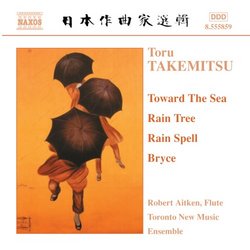

 Track Listings (10) - Disc #1
Track Listings (10) - Disc #1
